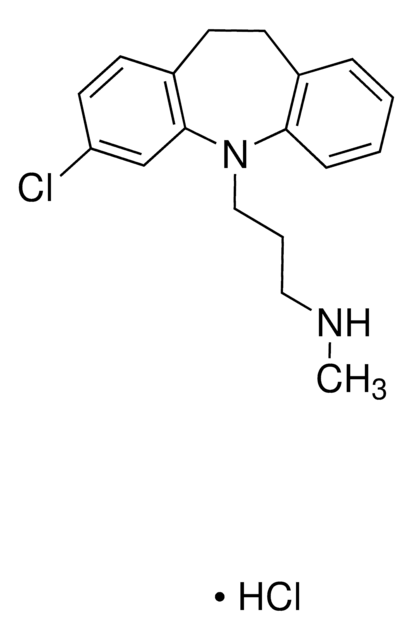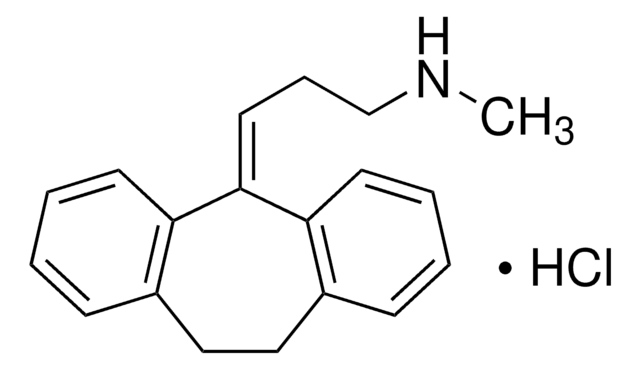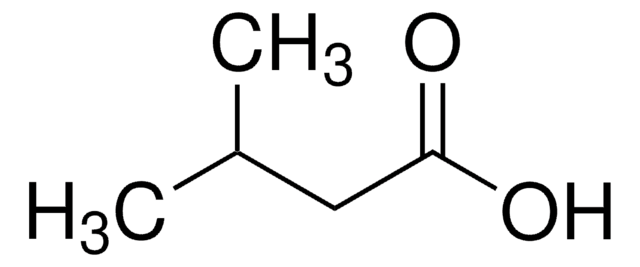P1386
Propionic acid
≥99.5%
Synonym(s):
Acid C3, Propanoic acid, Propanyl acid
About This Item
Recommended Products
vapor density
2.55 (vs air)
vapor pressure
2.4 mmHg ( 20 °C)
Assay
≥99.5%
autoignition temp.
955 °F
expl. lim.
12.1 %
impurities
≤0.25% water (Karl Fischer)
color
≤10, APHA:
refractive index
n20/D 1.386 (lit.)
bp
141 °C (lit.)
mp
−24-−23 °C (lit.)
density
0.993 g/mL at 25 °C (lit.)
SMILES string
CCC(O)=O
InChI
1S/C3H6O2/c1-2-3(4)5/h2H2,1H3,(H,4,5)
InChI key
XBDQKXXYIPTUBI-UHFFFAOYSA-N
Looking for similar products? Visit Product Comparison Guide
General description
Application
- Distribution Characteristics of Low-Molecular-Weight Organic Acids in Reclaimed Soil Filled with Fly Ash: A Study.: This research investigates the presence and distribution of propionic acid among other organic acids in reclaimed soils treated with fly ash. The study provides insights into the environmental impact and potential remediation strategies for soils contaminated with industrial by-products (Zheng et al., 2024).
- Effects of Black Soldier Fly (Hermetia illucens L., BSF) Larvae Addition on In Vitro Fermentation Parameters of Goat Diets.: This study examines how the addition of black soldier fly larvae affects the fermentation process of goat diets, including the production of propionic acid. The findings suggest potential benefits for improving animal nutrition and gut health (Lu et al., 2024).
- NMR Spectroscopy in Diagnosis and Monitoring of Methylmalonic and Propionic Acidemias.: This review highlights the use of NMR spectroscopy to diagnose and monitor methylmalonic and propionic acidemias, providing a non-invasive method for tracking these metabolic disorders. The study underscores the clinical significance of propionic acid in metabolic research (Deleanu & Nicolescu, 2024).
- The New Buffer Salt-Protected Sodium Butyrate Promotes Growth Performance by Improving Intestinal Histomorphology, Barrier Function, Antioxidative Capacity, and Microbiota Community of Broilers.: This study explores how propionic acid, along with sodium butyrate, improves the growth performance and gut health of broilers. The research demonstrates the beneficial effects of these acids on poultry farming (Melaku et al., 2024).
- Prevotella enterotype associates with diets supporting acidic faecal pH and production of propionic acid by microbiota.: This study links the presence of the Prevotella enterotype in the gut microbiota to diets that promote the production of propionic acid, emphasizing the role of diet in modulating gut health and metabolic functions (Adamberg & Adamberg, 2024).
Signal Word
Danger
Hazard Statements
Precautionary Statements
Hazard Classifications
Eye Dam. 1 - Flam. Liq. 3 - Skin Corr. 1B - STOT SE 3
Target Organs
Respiratory system
Storage Class Code
3 - Flammable liquids
WGK
WGK 1
Flash Point(F)
129.2 °F - closed cup
Flash Point(C)
54 °C - closed cup
Certificates of Analysis (COA)
Search for Certificates of Analysis (COA) by entering the products Lot/Batch Number. Lot and Batch Numbers can be found on a product’s label following the words ‘Lot’ or ‘Batch’.
Already Own This Product?
Find documentation for the products that you have recently purchased in the Document Library.
Customers Also Viewed
Our team of scientists has experience in all areas of research including Life Science, Material Science, Chemical Synthesis, Chromatography, Analytical and many others.
Contact Technical Service










